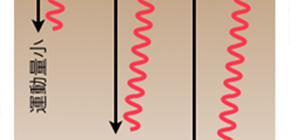
Successful non-destructive elementary analysis using a muon beam
A group of researchers of the research institutes and universities noted below, using the most intense pulsed muon beam in the world, MUon Science Establishment (MUSE) at the Japan Proton Accelerator Research Complex (J-PARC), succeeded in new non-destructive elementary analysis. Specifically, this group succeeded in non-destructive depth analysis of a variety of materials from meteorite simulant matter of a few millimeters in thickness to light elements such as C, B, N, O and non-destructive elementary analysis of carbonaceous chondrite meteorite including organic substances at the depths of 70μm and 1mm.
Osaka University -- TERADA Kentarou, NINOMIYA Kazuhiko
Japan Atomic Energy Agency -- OSAWA Takahito, HIGEMOTO Wataru
Hokkaido University -- TACHIBAN Shogo
High Energy Accelerator Research Organization -- MIYAKE Yasuhiro, KAWAMURA Naritoshi
International Christian University -- KUBO Kenya
Kyoto University -- TSUCHIYAMA Akira
Tokyo Metropolitan University -- EBIHARA Mitsuru
Japan Aerospace Exploration Agency -- UESUGI Masayuki
Negative muons (µ particles) are elementary particles with unitary negative electric charge of -1 and a mass of about 200 times that of the electron. Recently, the J-PARC succeeded in producing the most intense pulsed muon beam in the world and the technology was expected to be applied to a variety of fields.
Muon beam analysis features µ − particles acting as heavy electrons in the target materials. µ − particles have high transmission ability and can penetrate much deeper into materials than electrons. µ − particles which lost kinetic energy in materials are captured in elements at a certain depth. µ − particles captured in elements move to the orbit with lower level of energy while going around the orbit closer to the atomic nucleus than electrons and emit characteristic muonic X-rays. These characteristic muonic X-rays have about 200 times larger energy than that of characteristic X-rays generated by electron beam analysis such as EPMA (Electron Probe Micro Analyzer).
As the penetration of characteristic muonic X-rays into matter is high, it becomes possible to obtain information about chemical composition inside materials of a few centimeters thick in a non-destructive manner. This elementary analysis proposed more than 40 years ago was achieved by the most intense pulsed muon beam in the world by J-PARC for the first time.
The muon beam analysis capable of analyzing from the depth of light elements to heavy elements in a non-destructive manner is very unique. It is expected that this analysis will be helpful in non-destructive analysis of carbon concentration and the distribution of organic matters in rare samples to be brought by Hayabusa which is scheduled to be launched in 2014 and expected to return to Earth in December 2020.
Abstract
The recent development of the intense pulsed muon source at J-PARC MUSE, Japan Proton Accelerator Research Complex/MUon Science Establishment (10 6 s −1 for a momentum of 60 MeV/c), enabled us to pioneer a new frontier in analytical sciences. Here, we report a non-destructive elemental analysis using µ − capture. Controlling muon momentum from 32.5 to 57.5 MeV/c, we successfully demonstrate a depth-profile analysis of light elements (B, C, N, and O) from several mm-thick layered materials and non-destructive bulk analyses of meteorites containing organic materials. Muon beam analysis, enabling a bulk analysis of light to heavy elements without severe radioactivation, is a unique analytical method complementary to other non-destructive analyses. Furthermore, this technology can be used as a powerful tool to identify the content and distribution of organic components in future asteroidal return samples.
Figure 1

Figure 2
Figure 3
To learn more about this research, please read the full research report entitled " A new X-ray fluorescence spectroscopy for extraterrestrial materials using a muon beam " at this page of the Scientific Reports website.
Related link :
